AMD Ryzen 7 8700G and Ryzen 5 8600G Review: Zen 4 APUs with RDNA3 Graphics
by Gavin Bonshor on January 29, 2024 9:00 AM EST- Posted in
- CPUs
- AMD
- APUs
- Phoenix
- 4nm
- Zen 4
- RDNA3
- AM5
- Ryzen 8000G
- Ryzen 7 8700G
- Ryzen 5 8600G
CPU Benchmark Performance: Science And Simulation
Our Science section covers all the tests that typically resemble more scientific-based workloads and instruction sets. Simulation and Science have a lot of overlap in the benchmarking world. The benchmarks that fall under Science have a distinct use for the data they output – in our Simulation section, these act more like synthetics but, at some level, are still trying to simulate a given environment.
In the encrypt/decrypt scenario, how data is transferred and by what mechanism is pertinent to on-the-fly encryption of sensitive data - a process by which more modern devices are leaning to for software security.
Adding to our 2024 CPU suite, we've included the Montage Astronomical Image Mosaic Engine (MAIM) benchmark and OpenFOAM 1.2 and retained our gaming simulation benchmarks, including our Dwarf Fortress and Factorio benchmarks.
We are using DDR5-5200 memory as per the JEDEC specifications on the Ryzen 7 8700G and Ryzen 5 8600G, as well as DDR4-3200 on the Ryzen 7 5700G and Ryzen 5 5600G. The same methodology is also used for the AMD Ryzen 7000 series and Intel's 14th, 13th, and 12th Gen processors. Below are the settings we have used for each platform:
- DDR5-5200 CL44 - Ryzen 8000G
- DDR4-3200 CL22 - Ryzen 5000G
- DDR5-5600B CL46 - Intel 14th & 13th Gen
- DDR5-5200 CL44 - Ryzen 7000
- DDR5-4800 (B) CL40 - Intel 12th Gen

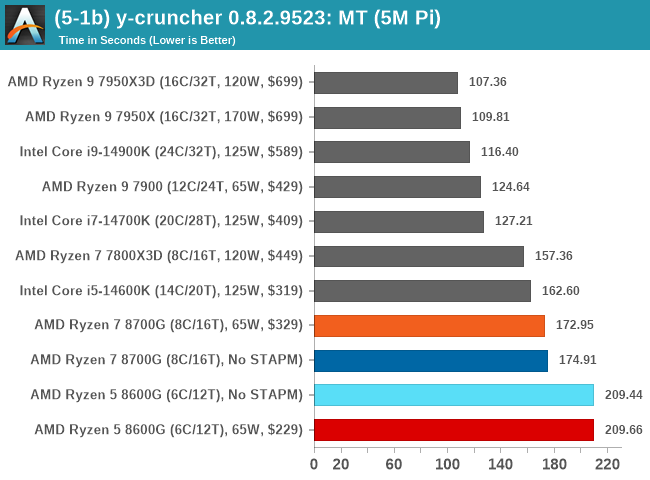
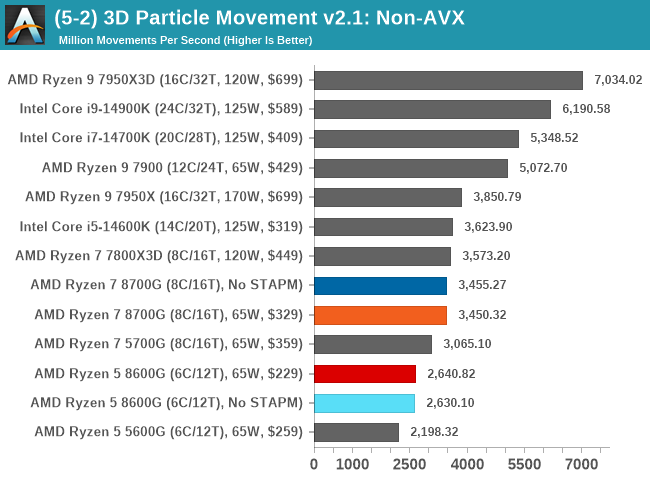


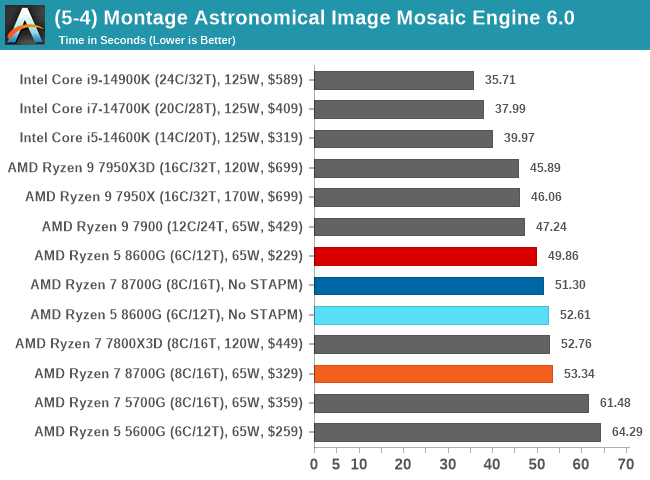
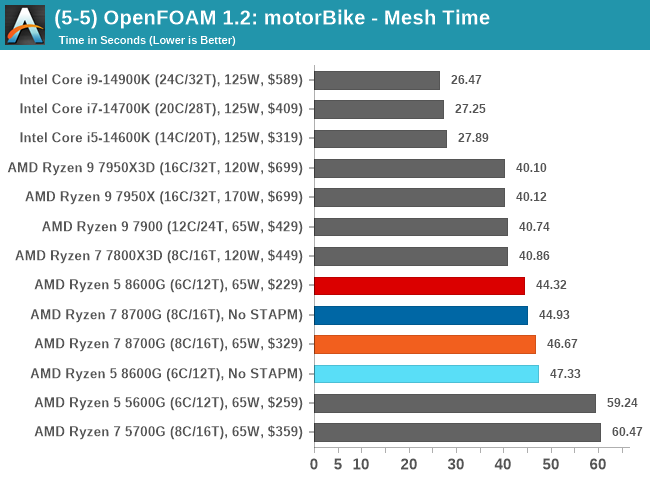
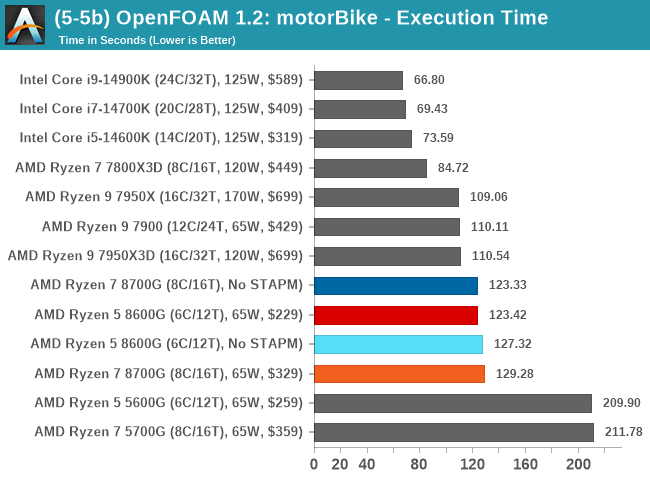

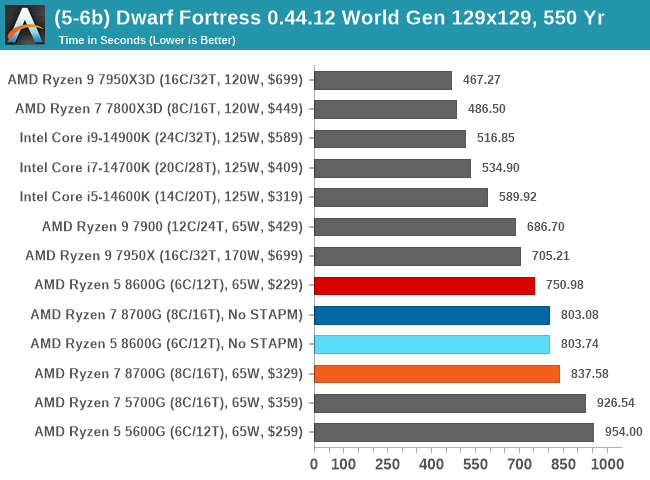
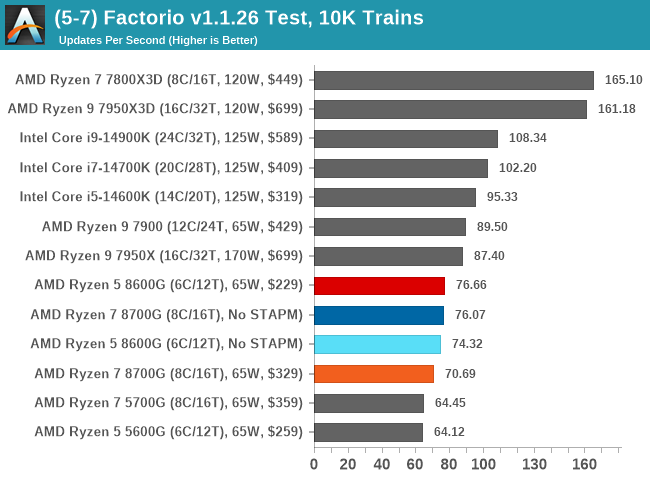
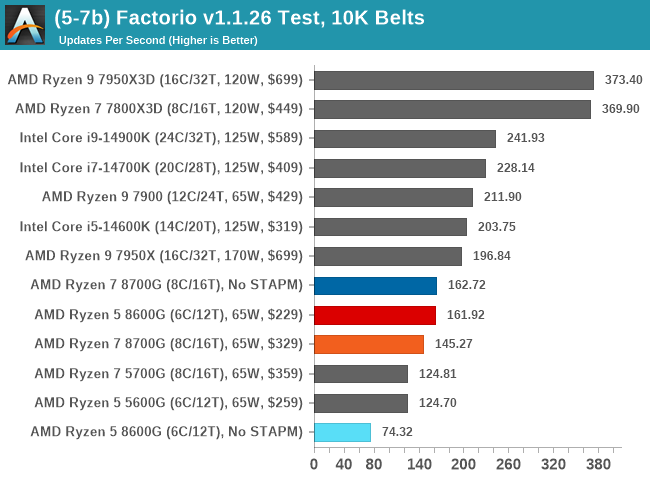
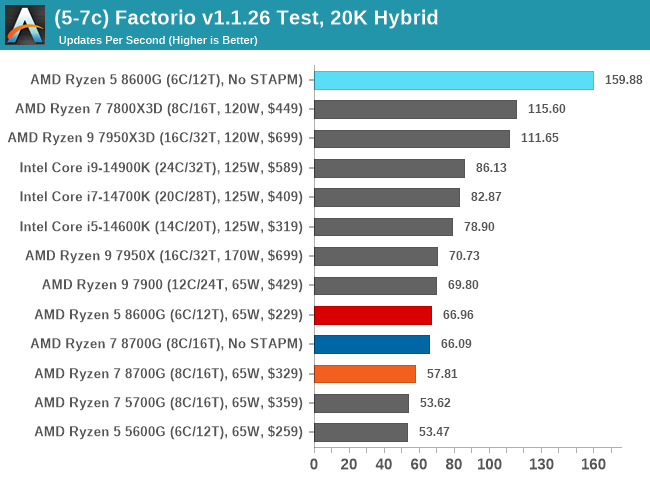
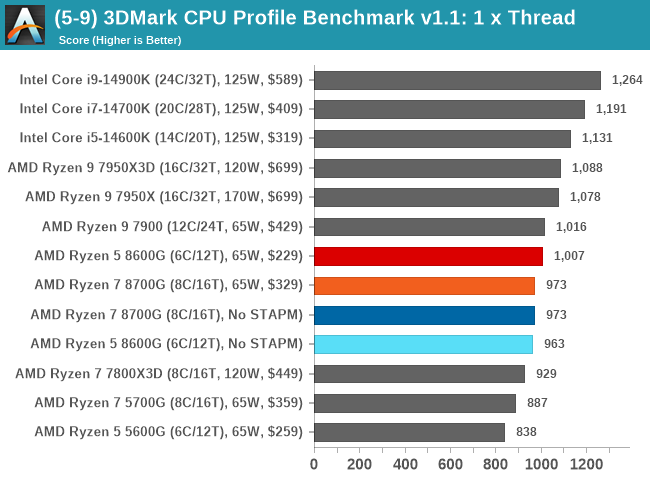
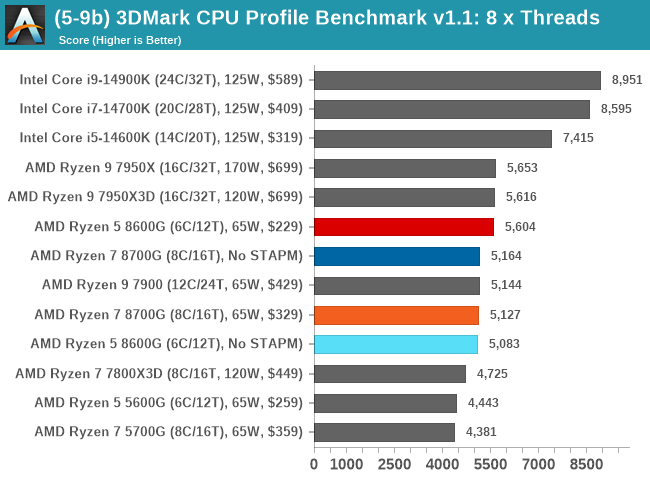
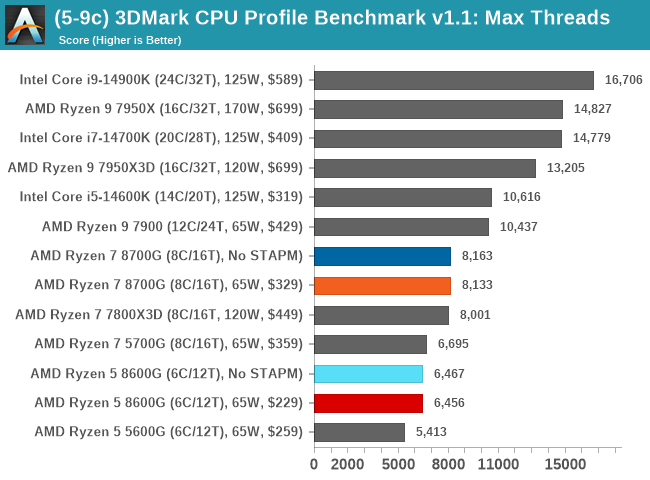
In our simulated and science-focused tests, much of the same happens here as we saw in encoding and rendering; bigger cores and more of them make the difference. We did see strong AVX performance, which is a given since Zen 4 supports AVX-512 workloads via two 256-bit channels. We also saw solid performance in y-Cruncher, with the Ryzen 5 8600G beating out the Ryzen 9 7900 in single-threaded performance. This shows that despite using more power-efficient Phoenix dies, Zen 4 on mobile still offers solid single-threaded performance when transitioned over to the desktop.
Testing without STAPM limitations in our Science and Simulation benchmarks and removing the sustained power management limits didn't really make much difference in performance in these tests.










111 Comments
View All Comments
TheinsanegamerN - Wednesday, January 31, 2024 - link
For basic use a 4 core is fine. Plenty of games still run fine on 4 cores, and if you are using the iGPU your CPU cores are not going to be your limiting factor.FatFlatulentGit - Wednesday, January 31, 2024 - link
That setup would also eat over 2x as much power. The 8000G line is for people who want something with some expansion options and decent performance, but also want to keep it lower power/heat/noise, among other things. I'm eyeballing one for an HTPC upgrade.t.s - Tuesday, January 30, 2024 - link
The problem with 8700G is the price. Too pricey. I'll take socketed CPU anytime over soldered If the price is right ($200-$250). Cause when you go 7840HS route, you can get complete packages with just $490 (16GB 5600MHz, 512GB SSD, BT5.2 + WiFi6) or about $390 no RAM no SSD.GeoffreyA - Tuesday, January 30, 2024 - link
Quite a nice boost in performance over the 5000G APUs, with only a slight increase of power. Though I suppose for those already on AM4 APUs, it may be better to wait for the Zen 5 ones, and get an even bigger boost in one shot.cp0x - Tuesday, January 30, 2024 - link
I've been reading Anandtech for decades, since it started. In all that time, this is the worst review I've ever seen. We already know these chip are budget / entry level (of the latest generation). There's only one thing that is truly interesting about these chips: The integrated graphics. And specifically, the IGP at 1080p. And while we get 4 pages full of tests of a discrete GPU with this CPU, we get a total of one page with the IGP at 1080p, and it contains only one chart comparing this chip with other options (e.g. Intel), and that one chart is of ... drum roll ... Civ6 🤦♂️ WTF!?!?!?!We do get a few more graphs of 720p gaming. Why?!? WHEN THE REVIEW ALREADY EXPLAINED THAT THE STEAM STATS SHOW MOST GAMERS PLAY AT 1080P?!?!?!?
I'm not going to assume that this is a conspiracy theory. After all: "Never attribute to malice that which is adequately explained by stupidity."
Come on. Do better. This article should have been centered around and anchored on the 1080p results with this chip's IGP. It should have compared with more than just AMD's previous gen of this chip; it should have compared with Intel's offerings in this space. The questions the reader has are: What $$$ video card does this thing save me from buying? Will this play my game? How does it compare with other CPUs and their IGPs?
End rant. Do better.
cp0x - Tuesday, January 30, 2024 - link
And of course (as other commenters have pointed out): What effect does slower or faster DDR5 make on the 1080p results? (Especially since faster DDR5 was actually being used in the Intel system.)FWhitTrampoline - Tuesday, January 30, 2024 - link
The tech press in general ignores iGPUs and small form factor systems save ETA Prime and his YouTube channel. But ETA Prime is Gaming Benchmark Focused there mostly so any Blender 3D Cycles iGPU accelerated testing is ignored there. AMD tends to only focus on Games development for its APUs mostly as the console makers using AMD's APUs are more responsible for the games performance on AMD's APUs than AMD is responsible.And really the Gaming Hardware review sights are higher end Desktop Processor/dGPU focused there where Very Small Form Factor(InWin Chopin and ASRock X300/Other Desk Mini SKUs that use AMD and Intel Socket Packaged processors with powerful iGPUs make sense) system builds are ignored!
Both the ASRock X300/Desk Mini and the Inwin Chopin very small form factor system builds and are too tiny to accommodate any dGPUs and so Ryzen 5000G was popular there for the iGPU and in those builds with AMD/Intel APUs/SOCs with more powerful iGPUs. There will be an ASRock x600/AM5 Desk Mini and what is essentially the same case form factor as the X300/AM4 Desk Mini. The Inwin Chopin barely accommodates a Mini-ITX MB but lacks the room of any dGPU to get slotted into the x16 slot on a Mini-ITX MB, sans some case modding of the Chopin!
Bruzzone - Tuesday, January 30, 2024 - link
1080 gaming, well, the real application for gamers running greater than a 6000 MHz memory bus is high frequency trading. mbnandnandnand - Tuesday, January 30, 2024 - link
I think the worst crime in the review was using DDR5-5200.Thunder 57 - Wednesday, January 31, 2024 - link
AT isn't the same since Dr. Ian Cutress left.